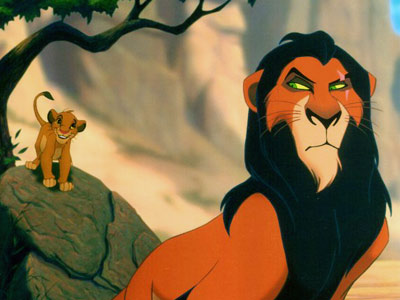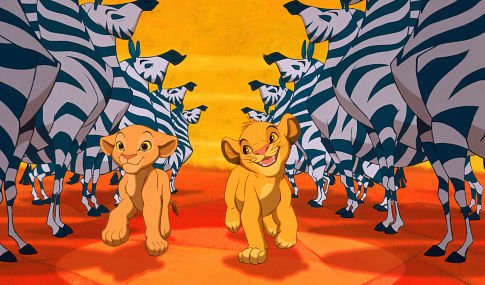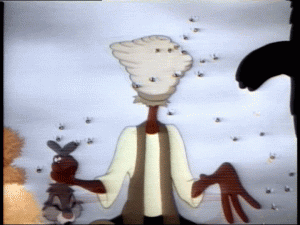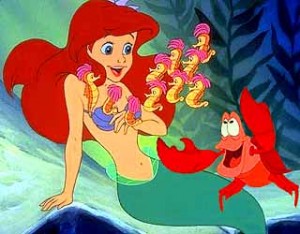From the Chicago Reader (July 22, 1994). — J.R.
** THE LION KING
(Worth seeing)
Directed by Roger Allers and Rob Minkoff
Written by Irene Mecchi, Jonathan Roberts, and Linda Woolverton
With the voices of Matthew Broderick, James Earl Jones, Jeremy Irons, Rowan Atkinson, Moira Kelly, Jim Cummings, Whoopi Goldberg, and Cheech Marin.
Though it’s somewhat less entertaining than The Little Mermaid, Beauty and the Beast, and Aladdin, The Lion King marks a welcome and fascinating shift in the Disney animated feature. It may be just a coincidence, but Disney’s new live-action Angels in the Outfield, a multicultural remake of a 1951 baseball fantasy, marks the same kind of racial and ethnic reorientation. I’d like to think that the widespread (and justifiable) objections raised by Middle Eastern groups to the xenophobic stereotypes in Aladdin have finally led to some rethinking by Disney executives about how to handle such ethnic material. If my hunch is correct, these changes represent not so much a kowtowing to political correctness as a more accurate reckoning of Disney’s stateside and international audience.
The issue isn’t exactly reality versus fantasy, because all Disney pictures are fantasies. In real life a white orphan isn’t likely to be adopted by a black man even if the white orphan’s best friend is a black orphan who comes along with the bargain (as in Angels in the Outfield). Real animals don’t speak English, much less with various ethnic and regional accents. The issue is what realities and what mythologies inflect the various fantasies.
For more than the past half century Disney cartoon features, whether animals or humans are the lead characters, have tended to exalt American WASP icons while relegating other ethnic types to the roles of comic servants. In the Disney depiction of blacks there’s very little difference between the bebop minstrel crows of Dumbo (1941), Brer Rabbit and Brer Fox in Song of the South (1946), and the Jamaican crab of The Little Mermaid (1989). There’s arguably even less evolution from Snow White (1937) to Cinderella (1950) to Beauty (1991). The fact that the voices of Pinocchio and the motherly fairy who watches over him are both identifiably American while all the villains in Pinocchio are either English or Italian is equally characteristic. Compare The Blue Light to Bambi, Triumph of the Will to Cinderella and Peter Pan, or Olympia to Fantasia, and it’s easy to see why Leni Riefenstahl hit it off so well with Walt Disney when she visited Hollywood in 1938: two Aryan idealists in love with childlike purity, they were visionary artists with compatible visions.
The Lion King doesn’t so much invert the usual Disney principle as confound it: black doesn’t become beautiful or white servile; rather, the categories get mixed up, stirred together into a melting pot. The lion hero, Simba, is seemingly white — Matthew Broderick is the voice — yet the lines of his father, Mufasa, are delivered by the recognizable voice of James Earl Jones; and Simba’s first musical number, “I Just Can’t Wait to Be King,” has a distinct Michael Jackson sound. Another clearly black character is Rafiki, a wise, eccentric shaman baboon whose lines are spoken by Robert Guillaume. Both Mufasa and his evil brother Scar look like George Sanders, and the latter’s voice is provided by Jeremy Irons; yet two of Scar’s three vicious hyena thugs are played by Whoopi Goldberg and Cheech Marin (the third, Jim Cummings, mostly laughs rather than talks).
Such mixtures mitigate and complicate the tribalism of the plot: the lion king — first Mufasa, then Scar, and finally Simba — lords it over the rest of the animals within a given territory known as the Pride Lands. Mufasa restricts the scavenging hyenas to the Elephant Graveyard (apparently for ecological reasons), but they invade the savanna with Scar’s blessing after Mufasa dies. Complicating matters further is the fact that the movie virtually equates a nostalgia for nature with nostalgia for old-fashioned royalty — epitomized by the enlightened (and ecologically correct) rule of both Mufasa and Simba. Meanwhile the Elephant Graveyard is viewed as a sort of urban blight, a dangerous, anarchistic slum overrun by a gang of ghetto hyenas.
Sexual stereotyping is submitted to a certain revision here as well. Though the father-son relationship of Mufasa and Simba seems patterned on some of Robert Bly’s notions about masculine identity, making all the female characters secondary, Simba’s betrothed has none of the fluttery femininity of the traditional Disney heroine. As a cub, Nala is mainly Simba’s pal, someone to accompany him on his adventures. And when we first encounter her as a lioness, her character isn’t gender specific at all. Simba has exiled himself after Mufasa’s death to the African forest, where he grows from cub to lion over the course of a single musical number. When Nala suddenly enters the forest, she’s merely a hostile beast; recognition of who she is comes only later.
Another change evident in The Lion King‘s configuration of characters has nothing to do with race or nationality or class or gender or city versus country — it has to do with something that might be called studio identity. Before Who Framed Roger Rabbit, Disney characters had a corporate identity readily distinguishable from the corporate identity of Warner Brothers cartoon characters; no one would ever have expected to see Bugs Bunny or Yosemite Sam wander into a Disney landscape, or vice versa. But Roger Rabbit brought characters from both studios together (along with characters from other studios, such as Droopy from MGM) and put an end to this de facto segregation. In The Lion King, Simba’s friends in exile — Pumbaa, a warthog, and Timon, a small mammal called a meerkat — are pure Warner Brothers, in their gruff personalities as well as their nasal voices, and their interactions with Simba and Nala carry the multiculturalism of the new Disney one step further.
The results of all these mixtures are still rather tentative, which is why The Lion King is marginally less entertaining than its immediate predecessors: it’s a transitional work. The expansion of thematic and stylistic options could lead to something better from the Disney studios if these new elements are creatively synthesized, and something distinctly less interesting and exciting if they’re not. Let’s wait and see.








